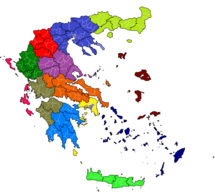
Back قائمة مقاطعات اليونان Arabic مقاطعات اليونان ARZ Yunanıstan rayonları Azerbaijani یونان سانجاقلاری نین فهرستی AZB Номы Грэцыі Byelorussian Ном (Гърция) Bulgarian Nomos Breton Prefectures de Grècia Catalan Nomau Groeg Welsh Præfekturer i Grækenland Danish
| This article is part of a series on |
| Politics of Greece |
|---|
 |
| Part of a series on the |
| Subdivisions of Greece |
|---|
 |
| First level |
| Second level |
| Third level |
|
| Autonomous Region |
| Obsolete terms |
|
51 Prefectural Administrations Prefectural Department, 2 Hyper-Prefectures 148 Provinces Municipal/Communal/Local Department |
During the first administrative division of independent Greece in 1833–1836 and again from 1845 until their abolition with the Kallikratis reform in 2010, the prefectures (Greek: νομοί, sing. νομός, romanized: nomoi, sing. nomós) were the country's main administrative unit. They are now defunct, and have been approximately replaced by regional units.[1]
They are called departments in ISO 3166-2:GR and by the United Nations Group of Experts on Geographical Names.[2]
The prefectures were the second-degree organization of local government, grouped into 13 regions or (before 1987) 10 geographical departments, and in turn divided into provinces and comprising a number of communities and municipalities. The prefectures became self-governing entities in 1994, when the first prefectural-level elections took place. The prefects were previously appointed by the government. By 2010, their number had risen to 51, of which one, the Attica Prefecture, where more than a third of the country's population resided, was further subdivided into four prefecture-level administrations (νομαρχίες, sing. νομαρχία). In addition, there were three super-prefectures (υπερνομαρχίες, sing. υπερνομαρχία) controlling two or more prefectures.
With the Kallikratis reform, which entered into force on 1 January 2011, the prefectures were abolished. Many, especially in the mainland, were retained in the form of regional units (περιφερειακές ενότητες) within the empowered regions, which largely took over the prefectures' administrative role.[1]
- ^ a b "Law 3852/2010 (Kallikratis reform)" (in Greek). Archived from the original on 2024-04-01. Retrieved 2024-04-01.
- ^ United Nations Group of Experts on Geographical Names: Administrative Division of Greece (Working Paper N° 95), New York 2000, (PDF 1,3 MB)]